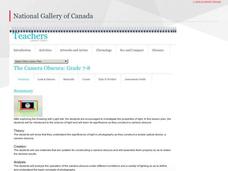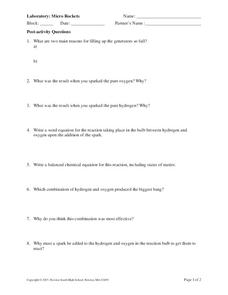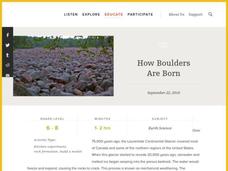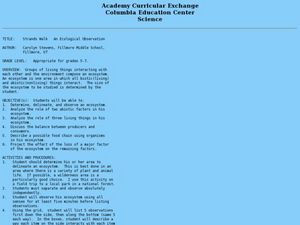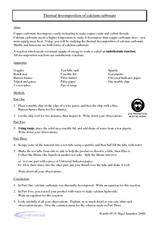Science 4 Inquiry
The Ups and Downs of Populations
As the reality of population decline across many species becomes real, pupils learn about the variables related to changes in populations. They complete a simulation of population changes and graph the results, then discuss limiting...
National Gallery of Canada
The Camera Obscura
You can create a camera with even the most unassuming materials. Learners view photographs and talk about the art. Some background information is included about the camera obscura for you to present before individuals make their own...
Curated OER
Laboratory: Micro Rockets
If you know how to employ the exothermic reaction between hydrogen gas and oxygen gas to make a miniature rocket, then this worksheet is a fabulous lab sheet for your chemistry charges. First, they observe a spark in pure oxygen and one...
Science Friday
How Boulders Are Born
Want your class to rock? Then try this boulder activity. Pupils learn about a specific boulder field and use edible materials to demonstrate the geological processes that formed this unique feature. Weathering, erosion, and mass...
Texas State Energy Conservation Office
Investigation: Splitting Atoms
In a simple activity, physical scientists model nuclear fission using a droplet of oil. This can be used alone in a unit on different types of energy, or as part of the energy conservation unit produced by the Texas State Energy...
Virginia Department of Education
Soap, Slime, and Creative Chromatography
Do you think chromatography paper suffers from separation anxiety? Young chemists make soap, slime, silly putty, and experiment with chromatography in this lesson. The material includes clear instructions for each experiment along with...
Science 4 Inquiry
The Real Story of Where Babies Come From
Pupils learn about both male and female anatomy before understanding how they work together to make a baby. Scholars discover new vocabulary, create a presentation on fertilization, and discuss related topics.
Illustrative Mathematics
Temperatures in degrees Fahrenheit and Celsius
Learners investigate the relationship between the Fahrenheit and Celsius temperature scales. Given two data points, they construct a linear function to describe the relationship, find the inverse of the function, and make observations...
Polar Trec
Plankton Parents
Plankton are so abundant in the ocean they outweigh all of the animals in the sea. In this three day activity, groups discuss and become familiar with plankton, capture females, and look for egg production on day three.
Nuffield Foundation
Going up in Smoke
Don't let all your hard work go up in smoke. Pupils conduct an experiment to see the harmful effects of cigarette smoke. They observe how smoke changes the color of white wool and an indicator solution.
Curated OER
Strands Walk-An Ecological Obseravtion
In this ecosystem activity, students investigate an ecosystem at a local park or national forest, they make observations for five minutes, they complete a grid of their observations and they construct a hypothetical food chain. Students...
Curated OER
Lunar Cycle
Young scholars recognize that the eight phases of the moon repeat. In this lunar cycle lesson, students experiment to understand the phases of the moon. Young scholars make observations and complete a "the Moon I See" worksheet. ...
Curated OER
REDOX Lab
Students produce copper metal by electrolysis. In this REDOX lesson plan, students use a copper (II) chloride solution and a 9 volt battery to produce copper metal through an electrolysis reaction. Students make observations and take...
Curated OER
Star Light, Star Bright: Exploring How Stars are Classified
In this star classification worksheet, students are given laminated star charts to make observations about stars. They work in groups to classify groups of stars based on different characteristics. For each group of stars they list at...
Curated OER
Mystery Creek
Fourth graders are introduced to the Riparian Ecosystem. They define the following terms: riparian and riparian ecosystem. Students take a trip to the creek, where they make observations about the environment around them. They are...
Curated OER
Water and Ice
Students make observations of ice as it melts. In this phase change lesson, students observe ice as it melts in a cup. They discuss their observations and place the cup of water into a freezer to change it back into ice.
Curated OER
Density Phenomena-Using the Concept of Density
Students investigate the concept of density by observing demonstrations. In this density lesson plan, students make observations while the teacher demonstrates the Cartesian diver, a density column, a candle trough, a wave bottle, an...
Curated OER
Seed Germination
Students explore the process of seed germination. For this botany lesson, students complete an experiment with seeds. Students observe soaked and dry seeds. Students allow the seeds to germinate and make observations during this time....
Curated OER
Some Halogen Chemistry
In this halogen chemistry worksheet, learners complete a practical to gain experience making observations of inorganic halogens and their salts. Students make observations of changes that take place in each chemical reaction and they...
Curated OER
Thermal Decomposition of Calcium Carbonate
In this thermal decomposition of calcium carbonate worksheet, students perform three experiments on calcium carbonate, make observations and write the equations for each reaction. Students explain in detail what happened at each step and...
Curated OER
The Effect of Concentration Changes on Equilibrium
In this concentration changes and equilibrium worksheet, students experiment with iron (III) ions and thiocyanate ions to observe the effects of concentration on the equilibrium of solutions. Students make observations of their mixtures,...
Curated OER
Discovering Seeds
Young scholars compare seeds with seedlings. In this life science lesson, students make observations of seedlings and the seeds they grew from, paying special attention to the roots. Lesson includes extension activities.
Curated OER
Properties of Soaps
Learners investigate 3 types of soap. In this properties of soaps lesson plan, students test soap with pepper and observe the reaction between the two. They make observations of the 3 types of soaps and make a chart to compare each. They...
Curated OER
Chemical and Physical Changes Lab
In this chemical and physical change worksheet, learners conduct a variety of experiments with unknown solutions and make observations. Students determine if the properties of the solutions have changed and if there is...



